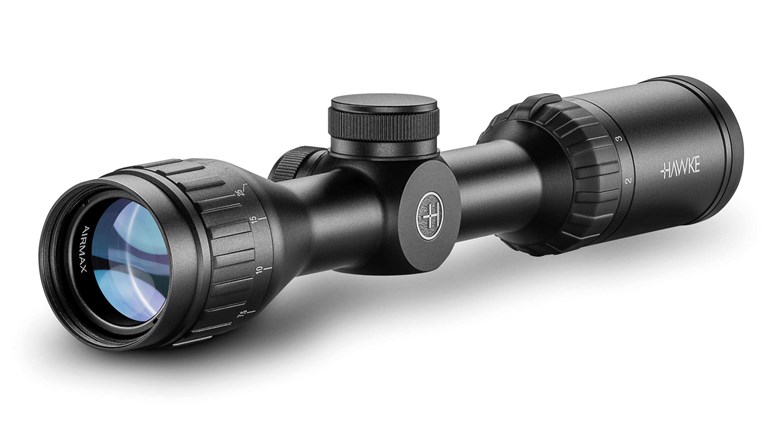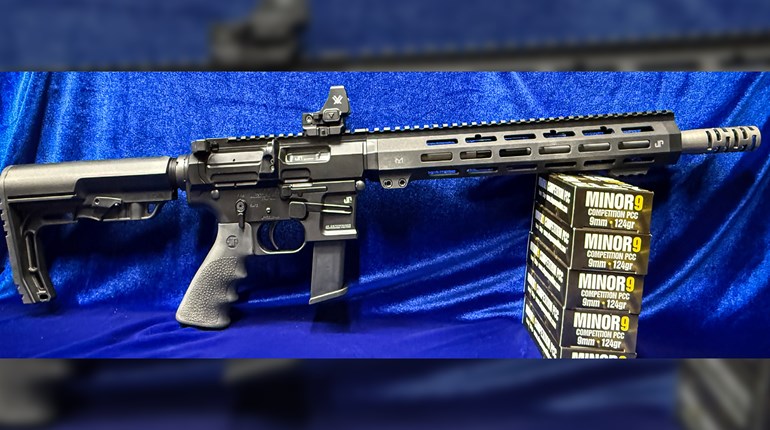
If you want a riflescope that with a single push of a button laser ranges your target, provides the real-time ballistic data of your cartridge and automatically adjusts your aiming point to make the shot, you’re in luck. Burris has just the scope for you. Too good to be true? No. The newly introduced Burris Eliminator 6 4-20x52mm is the latest model in their line of riflescopes that incorporates a laser rangefinder, a ballistics computer and a heads-up display. This is also the first model in their Eliminator series that uses a standard, round main tube rather than a proprietary housing with integrated mounts. Aimed at hunters who want to accurately shoot beyond point-blank range quickly without having to rely on mechanically adjusting the scope or holding over the target, the Burris Eliminator 6 is an impressive piece of equipment. Does it work? Yes. Is it perfect? No. Is it better than just using The Force when taking a long-distance shot? Absolutely.

Disregarding the electronics for a moment, the Eliminator 6 4-20x52mm is a straightforward riflescope, albeit a bit heavy at 30 ounces. It’s built on a 34mm main tube, has side parallax adjustment, a fast focus eyepiece, uses a 5X magnification range system and has a large magnification selector ring. The adjustments deviate a bit from most riflescopes in that each “click” is ⅛ MOA instead of ¼ MOA. This is a nice touch, giving the shooter the ability to more precisely zero the optic than with ¼ MOA adjustments or 1/10th MIL adjustments. It also gives the shooter the opportunity to waste some ammunition through user error by not looking to see what the adjustment values are, then wondering why it’s not moving the amount that he, meaning me, thinks it should. Ask me how I know. The windage and elevation knobs are covered with caps, as this scope isn’t intended to be dialed for making the shot, that’s what the electronics are for. The reticle is a long-range “Christmas tree” type that has a center aiming point and a thick post down the middle with increasing windage holds off to each side. The reticle has micro-LEDs in the center line that provide the aiming point via the scope’s electronics.
It’s the electronics that set the Eliminator 6 apart from other riflescopes. The Eliminator 6 has a laser rangefinder that works on reflective targets out to 2,000 yards. It also has a built-in thermometer, barometer and inclinometer that work together to automatically measure the density altitude. The density altitude, or DA, can be manually adjusted as well. Using the environmental data, the Eliminator 6 selects the ballistics solution for your cartridge, which you upload to the scope via Bluetooth connectivity and the BurrisConnect app. Relevant ballistic information including range-to-target, the calculated point of aim, the windage hold, level indicator and energy/velocity of the cartridge at the target are all easily seen while looking through the scope via a heads-up-display (HUD). A “shot call indicator” is also visible, meaning if the shot is too far for cartridge, an “X” will appear. This tells the hunter not to take the shot. A battery status indicator is also visible. Three buttons on the side of the parallax knob operate the electronics and adjust the HUD brightness. A remote control for using the laser rangefinder is included. This can be attached to a rifle stock, kept in a pocket, lost if you’re a hot mess like me, etc.

After uploading your cartridge’s data to the Eliminator 6, bringing all this technology to bear is simple. Put the reticle on the target, and press the large button on the scope or the remote to use the laser rangefinder to get the distance. This and the other ballistic information will be displayed on the HUD, including an illuminated dot on the vertical reticle that is the correct aiming point for distance to target. Hold the dot on target, adjust for the wind by using the displayed information for windage, and take the shot. It is that easy, sort of.
The reticle is an interesting piece of technology. It’s a second focal plane reticle, which means the hash marks will have different values at different magnifications. Normally this makes it difficult to use lines on the reticle for aiming and wind holds except for at one designated magnification setting. The electronics in the Eliminator 6 compensate for the value of the hashmarks throughout the power range. So, at the lowest power, the value for each windage hold is greater than at the higher magnification. As you rotate the power selector from its lowest setting to its highest setting, you can watch the data change in real time to reflect the updated value. This is impressive.

Luckily, I was able to obtain a sample of the Eliminator 6 for testing. Unboxing was a bit different from the norm as the package includes the remote, some zip ties and Velcro for attaching the remote, a quick-start guide and an instruction manual. Normally I channel my inner Neanderthal and toss instructions so I can suffer through setup by trial and error. In this case I decided to not only keep the instructions but actually read them. I’m glad I did. With them, setup and uploading your cartridge data in the app is quick and easy. For this test I mounted the Eliminator 6 on a Savage 110 in .308 Win. customized with a Proof Research carbon-fiber barrel.
Zeroing the scope was straightforward once I remembered the adjustments were in ⅛ MOA rather than the typical ¼ MOA. Optically the scope looks good with no major issues while looking for distortion around the edges, clarity, etc. Because this scope is not designed to run the dials, I didn’t shoot a box test to evaluate the adjustment’s repeatability. It was the performance of the onboard electronics and processing I was most interested in.
All this technology is fine and dandy on the range, but how did it work in the field? In this case “the field” is the coastal range of Oregon. I took the setup to a clear-cut where I can shoot at various ranges out to just over 600 yards. Overall everything worked great. The scope ranged targets and provided the aiming point—and the data seemed to be spot on. It was no problem hitting an MGM Targets mini-IPSC steel plate at 612 yards with the aiming point. There are a few things to be aware of, though.
Most importantly, you still must read the wind. You can’t just get the range and rely on the aiming dot. Reading the wind takes practice. If you’re going to shoot at game at any sort of long distance, please practice. By default, the scope gives wind data for a 10 mph crosswind. You can adjust this value in the app and upload it to the scope. You can also just multiply the wind data by your wind estimate. For instance, if the wind is only 5 mph, then just take the windage data shown in the HUD and cut it in half.
It is important to note that often while hunting you range targets while standing or kneeling, which may let the rangefinder clear brush in front of you. Your line of sight may not be as open when shooting prone and using the Eliminator’s rangefinder. I had a clear line of sight to the target at 600 yards but was getting a 34-yard reading from a bush in front of me. This isn’t a deal killer, but it is something to be aware of using the scope in actual hunting conditions.

Because it’s on the second focal plane and does not have numbered vertical hash marks, the reticle will become no more useful than a standard “crosshair” style reticle without the electronics. Because of this, it would be best to zero this scope at 200 yards rather than 100 yards. That way if the battery dies you can still effectively make shots out to 300 yards with most cartridges without having to aim over an animal.
The scope seems durable enough. I purposely dropped it a few times on the road, onto logs, the ground, etc., with no adverse effects on performance. It also survived being submerged in water for 30 minutes.
Overall, this is an amazing scope that was a lot of fun to learn and to shoot. Burris did a great job with this latest model in their Eliminator series, in particular by getting all this functionality into a standard scope tube rather than the proprietary housing setup they used previously. For anyone who wants to responsibly shoot game or targets beyond point-blank range, this could be a great option. The time it saved by not having to range with a separate optic, look at a DOPE card and make a scope adjustment could prove critical in some hunting situations. Legality may be an issue in your state, so you’ll have to check your local regulations, but if this impressive functionality appeals to you, then the Eliminator 6 is worth a look.
Technical Specifications
• Type: variable-power, laser-rangefinding riflescope
• Magnification: 4X-20X
• Objective Lens Diameter: 52mm
• Eye Relief: 3.4"
• Exit Pupil: 8.6mm (4X), 2.9mm (20X)
• Field of View @ 100 Yards: 30.5 ft. (4X), 6.5 ft. (20X)
• Reticle: X177 Eliminator 6, illuminated, HUD
• Adjustments: ⅛ MOA
• Ranging Distance: ≥ 2,000 yds. (high reflective), ≥ 1,800 yds. (deer hide)
• Lens Coatings: fully multi-coated
• Tube Diameter: 34mm
• Length: 14.6"
• Weight: 30 ozs.
• Construction: one-piece aluminum body; HD glass; matte black finish
• Battery: CR123A (scope, x1), CR2032 (remote, x1)
• Accessories: remote
• MSRP: $3,000; burrisoptics.com





































